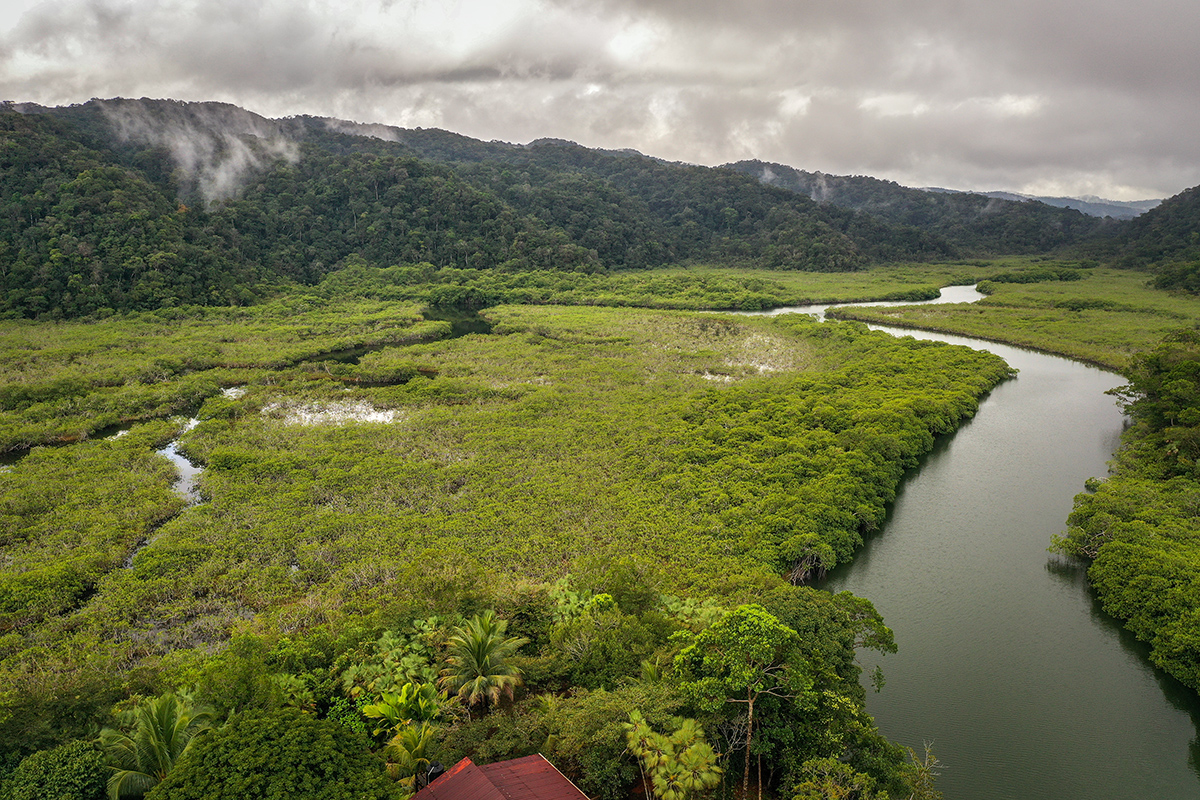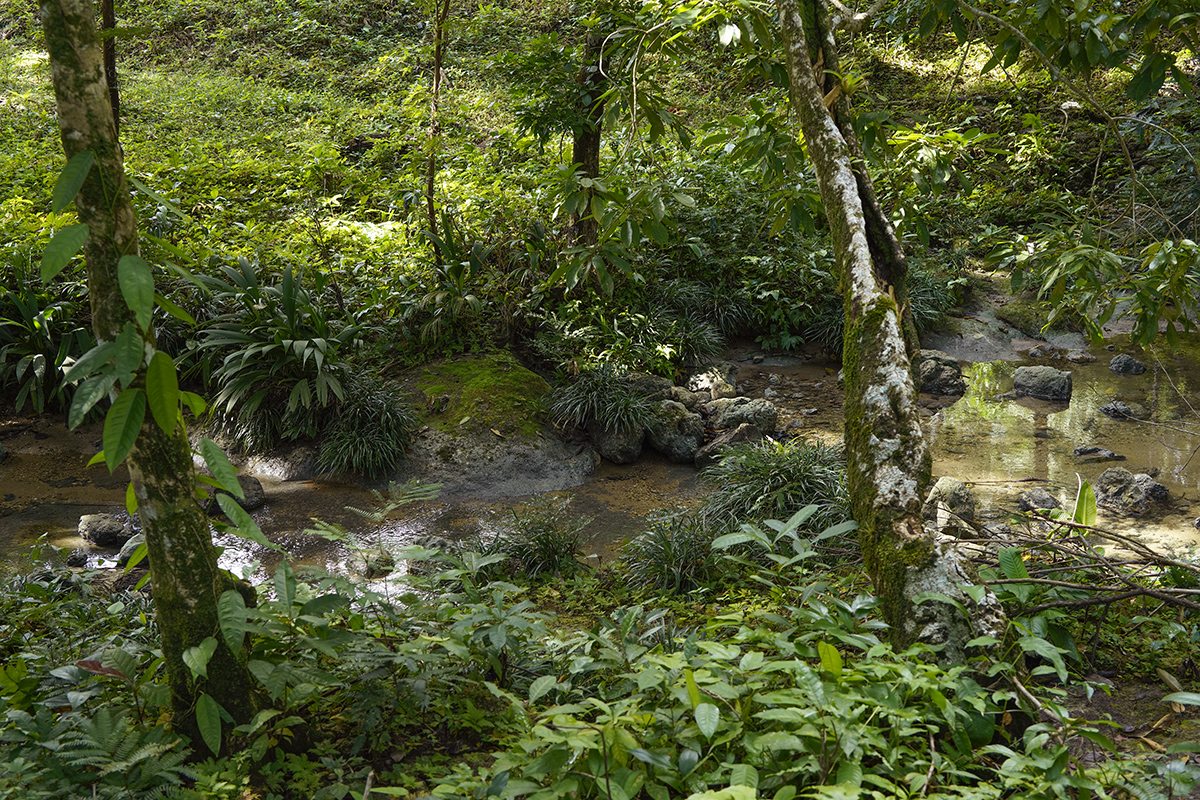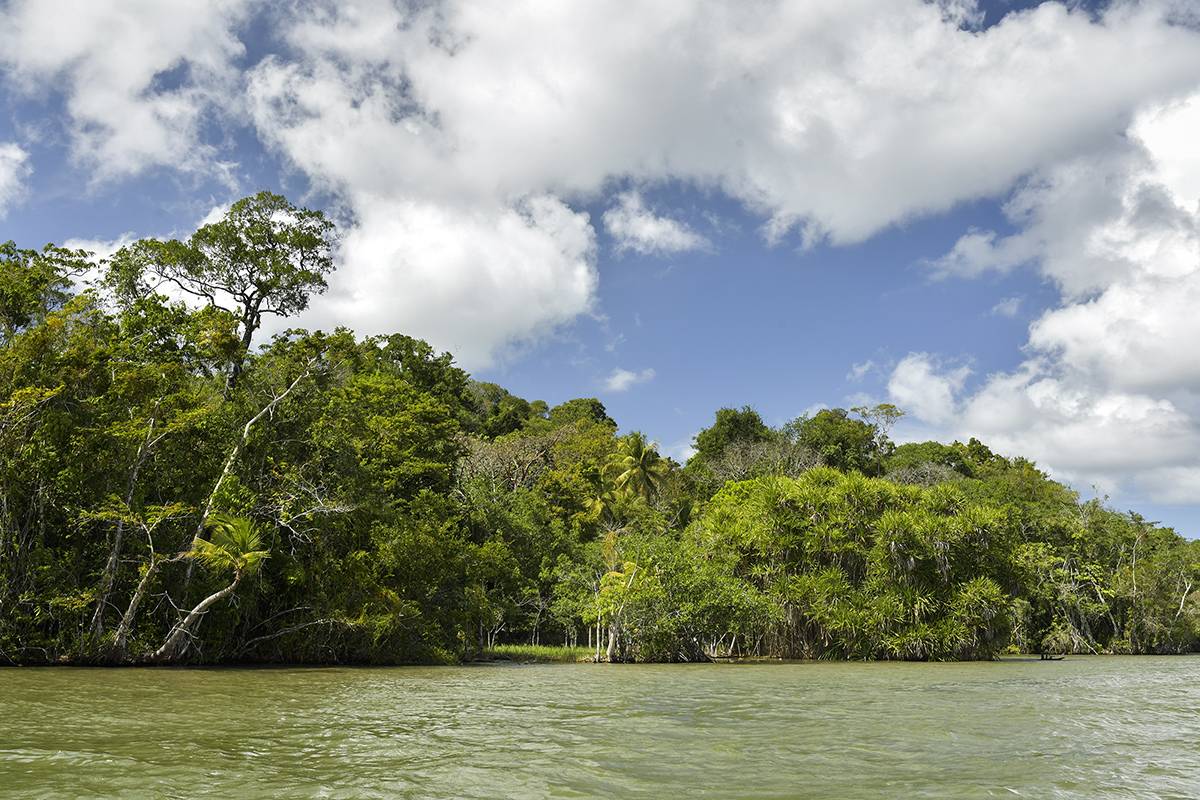In March we celebrate the International Day of Forests (March 21th) and World Water Day (March 22th), two commemorative dates for life and the vital resources for the functioning of this planet.
Water is an essential element of any living organism and fundamental for sustainable forest management. Forests are crucial for regulating the hydrological cycle and buffering climate change. Both are important and indispensable resources for our planet that depend on each other. The Earth is the only planet we know capable of sustaining life and the beings that inhabit it and depends directly on the resources it offers us. For this reason, forests and bodies of fresh water constitute the main reservoirs of life resources on the planet.
 Sarstún River Landscape. Livingston, Izabal, Guatemala.
Sarstún River Landscape. Livingston, Izabal, Guatemala.
David Arrivillaga, 2020. FLAAR Mesoamerica.
The role of the forest in the water cycle
When we think about forests, the first thing that comes to mind is fresh air and a green landscape. However, forests also play an important role in the water cycle which is made up of several stages. Starting in the oceans and large water surfaces such as rivers or lakes. In them the sun heats the water until it evaporates. When it condenses, clouds form and most of it precipitates on the same bodies of water. A part falls to the surface and returns to the atmosphere through evaporation and evapotranspiration from vegetation. The other part drains through rivers and streams until it reaches its final destination which is the sea where the cycle returns to its initial phase.
 Rain in the Tropical Forest. El Pinar, Reserva de la Biosfera Maya, Petén, Guatemala. Haniel López, 2023. FLAAR Mesoamerica.
Rain in the Tropical Forest. El Pinar, Reserva de la Biosfera Maya, Petén, Guatemala. Haniel López, 2023. FLAAR Mesoamerica.
This cycle would not be complete if it were not for forests since they help maintain good water quality, influence their availability and contribute to the reduction of water-related risks such as landslides, floods and droughts. Forests create the conditions to prevent water from going downhill, erosion and landslides. Vegetation allows water to be retained and seek other ways of filtration. In turn, beneath the forests there are fractured layers where water is filtered and enriches the underground stores of the water table.
Forests can mitigate extreme weather events and reduce the effects of climate change as they perform buffering, cooling, rain interception and infiltration, and water retention functions. On the other hand, these are capable of removing and storing carbon from the atmosphere, avoiding and reducing atmospheric emissions of greenhouse gasses. From an ecological point of view, forests allow climate regulation and cushioning the impact of natural phenomena. In addition, they provide protection to diversity and ecosystems, promote the pollination of plants and the biological control of pests, recycle and degrade organic waste, and allow the generation and recovery of soils.
 Pine and Tasiste Ecosystem. El Pinar, Reserva de la Biosfera Maya, Petén, Guatemala. Nicholas Hellmuth, 2023. FLAAR Mesoamerica.
Pine and Tasiste Ecosystem. El Pinar, Reserva de la Biosfera Maya, Petén, Guatemala. Nicholas Hellmuth, 2023. FLAAR Mesoamerica.
The role of water in forests ecosystems
Water is a natural good that is essential for the functioning of living beings. Humans, biodiversity, the environment and any form of life need it. It is one of the most present resources in living beings and it is not just about drinking it or staying hydrated. Water is a regulator of terrestrial ecosystems since it maintains the balance necessary for animal and plant subsistence. For humans, its importance is evident, since it is present in all our body tissues and vital organs. The same happens for the rest of living beings.
Forests are also important users of water. Trees consume the most water when they reach their maximum height and during the most intensive growing season. The water consumed by forests depends on climate, topography, soil, tree age, species composition and management practices. When water is lacking, there are multiple negative effects on their health. Unfortunately, global water availability declines each year and forests are equally vulnerable to changes in precipitation patterns and the effects of climate change.
 River and Forest Landscape. Plan Grande Tatín, Livingston, Izabal, Guatemala. David Arrivillaga 2020. FLAAR Mesoamerica.
River and Forest Landscape. Plan Grande Tatín, Livingston, Izabal, Guatemala. David Arrivillaga 2020. FLAAR Mesoamerica.
Threats to forests and the hydrological cycle
At the same time, forests face multiple threats, including the expansion of agriculture,livestock and urban areas, where deforestation is an inevitable practice. The largest percentage of land area on the planet has been converted into agricultural fields for the production of high-demand products such as coffee, cocoa, sugar, palm oil and soybeans. Likewise, they are deforested due to the high demand for firewood and paper. Affecting natural climate patterns and the diversity of species that inhabit them.
In connection with deforestation, the hydrological cycle depends on the absorption of water in the atmosphere by trees. Trees act as reservoirs, taking water from the ground and releasing it into the atmosphere through their leaves. That moisture formed in the air results in the formation of clouds, eventually causing rain and the continuity of the water cycle. As more trees are cut down or deforested, evaporation levels are disrupted, reducing humidity in the air and unbalancing the water cycle. A continued cycle of dry air, low humidity, and decreased precipitation will inevitably lead to a drought-prone desert climate.
 Mangrove swamp forest. Cayo Palomo, Izabal, Guatemala. David Arrivillaga, 2020.
Mangrove swamp forest. Cayo Palomo, Izabal, Guatemala. David Arrivillaga, 2020.
In turn, infiltration and runoff are other components of the water cycle affected by deforestation. Typically, tree roots absorb rainwater, ensuring an adequate amount of infiltration and reduced levels of runoff. However, deforestation promotes the opposite course of action: less infiltration and greater amounts of runoff. Without trees, there is nothing to support the ground cover. Soil erosion rates increase, leading to flooding concerns and increased chances of contaminants reaching nearby water reservoirs.
Threats to ecosystem services and food security
Forests also provide non-carbon services that are essential for human societies to thrive: from their role in maintaining livelihoods, to providing water and food security, and regulating global rainfall patterns. However, approximately 10 – 12 million hectares of forest are destroyed each year (Ritchie, 2021). This deforestation, along with agriculture and other land use changes, is responsible for about 25 percent of global greenhouse gas emissions. Deforestation and land degradation also undermine efforts to increase resilience to climate impacts and threaten forest-dwelling communities.
 Tropical Forest Landscape. Tikal National Park (PANAT), Petén, Guatemala. Haniel López, 2022. FLAAR Mesoamerica.
Tropical Forest Landscape. Tikal National Park (PANAT), Petén, Guatemala. Haniel López, 2022. FLAAR Mesoamerica.
Billions of people suffer from the effects of inadequate access to water. In many regions of the world, available water resources are exploited; their contamination and misuse represent an increasing threat to their availability and quality. Climate change has exacerbated water scarcity and greatly threatens food security, being one of the causes of mass migrations, increasing social and political conflict.
Ironically, humans deforest large amounts to be able to grow crops and ensure food. Around 75% of the planet’s freshwater generated by forests is used in agricultural production, and for domestic and industrial use (Eberhardt et al., 2019). However, we do not take into account that food security depends on water security and water security depends on forests. Trees are essential to be able to maintain all of our production systems. Both soil and water are conditionally essential for the growth and health of our plants, trees, forests and the rest of the living beings that make up these ecosystems.
 Tropical Forest Landscape. Tikal National Park (PANAT), Petén, Guatemala. Haniel López, 2022. FLAAR Mesoamerica
Tropical Forest Landscape. Tikal National Park (PANAT), Petén, Guatemala. Haniel López, 2022. FLAAR Mesoamerica
The hydrological cycle is of great importance for all ecosystems and climate regulation. Water is capable of modifying the life of the planet’s ecosystems and is essential to sustain biodiversity. Forests are essential to sustain that life and to regulate the water cycle. In this context, we must take into account the importance of both resources as fundamental pillars for the fight against climate change and the permanence of natural ecosystems and thus be able to ensure our future generations the resources necessary for their subsistence.
Cited References
- 2017
- Bosques, suelo y agua: explorando sus interacciones. Revista Científica de Ecología y Medio Ambiente, Vol. 26, No. 2, Pages 1 – 9.Available online:
https://funcagua.org.gt/wp-content/uploads/2020/04/2017.-Bosques-suelo-y-agua-Explorando-sus-interacciones.pdf
- 2007
- Forest and Water – Ensuring forest benefits outweigh water costs. Forest Ecology and Management, Vol. 251, No. 1 – 2, Pages 110 – 120.
- 2007
- Towards a new understanding of forest and water. Food and Agriculture Organization (FAO). Unasylva 229, Vol. 58.
- 2019
- Advancing the Forest and Water Nexus: A Capacity Development Facilitation Guide. Food and Agriculture Organization of the United Nations (FAO), Rome, Italy.
- 2013
- Forest and Water: international momentum and action. Food and Agriculture Organization of the United Nations (FAO).
- 2021
- Deforestation and Forest Loss. OutWordInData.org. Retrieved from: https://ourworldindata.org/deforestation.
- 2021
- Forest Resources Assessment. – processed by Our World in Data. “Annual deforestation rate”. UN Food and Agriculture Organization (FAO). Forest Resources Assessment.
- 2018
- Forest, atmospheric water and uncertain future: the new biology of global water cycle. Forest Ecosystems, Vol. 5, No, 9.
- 2018
- Managing forests for cleaner water for urban populations. Food and Agriculture Organization (FAO). www. fao.org/docrep/010/a1598e/a1598e10.htm
Written by Biologist Flor Morales Arroyo

